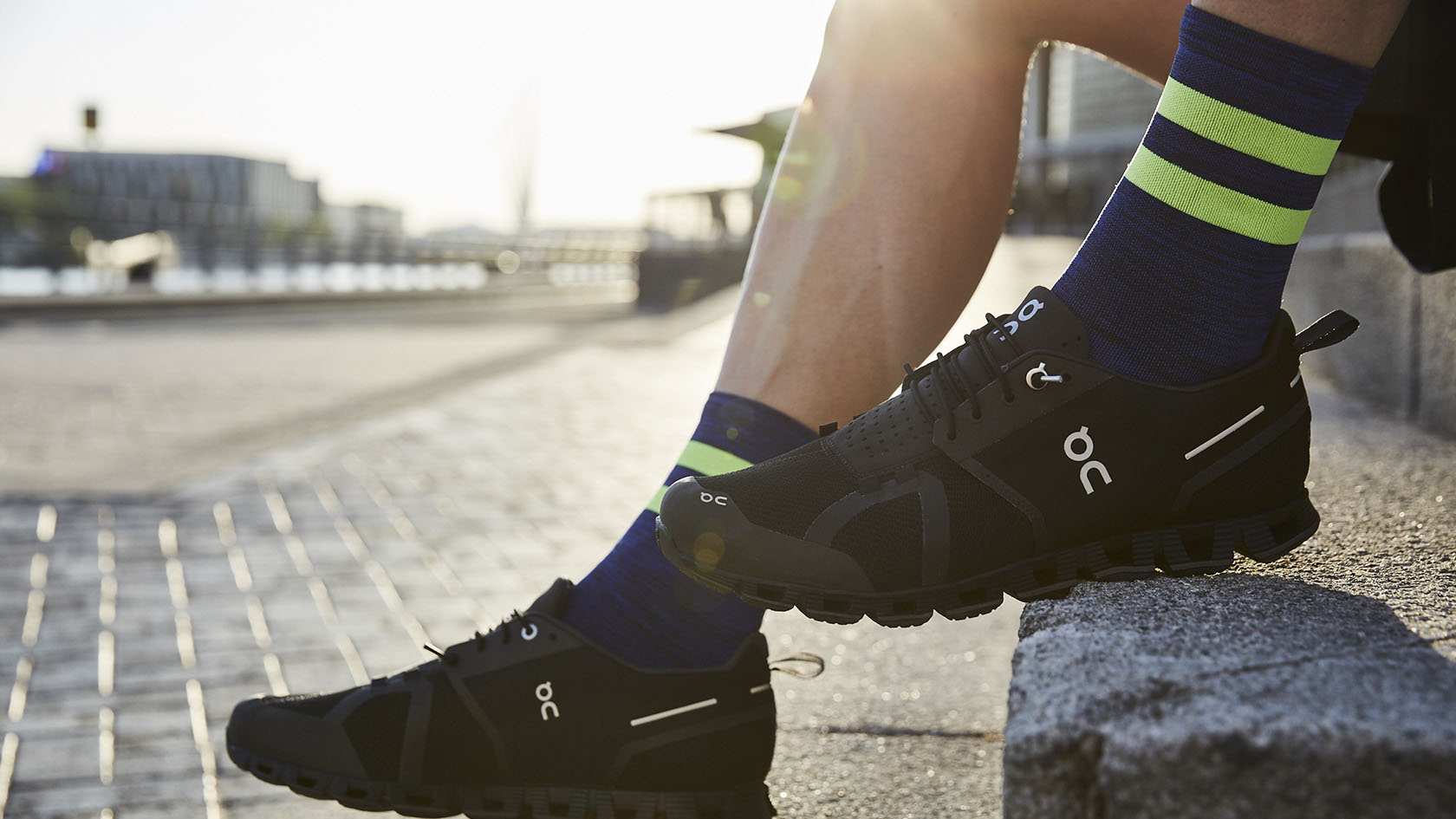SIMPLE TIPS TO PREVENT RUNNING INJURIES
Running gives you the freedom to take part anywhere, anytime, at your own pace. Neverthless injuries are bound to arise so it's vital to be aware, train proficiently and stay ahead.
We caught up with Andy Hobdell, one of the coaches from Swiss performance running brand On, who shared his tips to prevent even the simplest of running injuries.
Andy Hobdell, an ON Coach
“For me my daily run is like my reset button. I could wake up tired and cranky, however after my morning run I’m good to chase the day, or after a slog of a day at work I can head out for a run and return with the working day now a distant memory.”
It is on this note that I give you some simple to tips to hopefully help keep you injury free.
1. Wear the correct type of running shoes based on your foot type and running style
Wearing the right running shoes is one of the most effective ways to prevent running injuries. Not all running shoes are created equal - your ideal shoe depends on both your foot type and your running style.
Each time you run, your feet absorb a force up to three times your body weight. The right shoes help distribute this impact, reducing the risk of injuries like shin splints, plantar fasciitis, and stress fractures.
Understand Your Foot Type and Pronation
Your foot type is determined by the structure of your arch and how your foot rolls (pronates) when you run. There are three main pronation types, each requiring different shoe features:
- Neutral Pronation
- Foot rolls inward slightly, distributing weight evenly.
- Typical for runners with normal-size arches.
- Best suited to stability shoes with balanced cushioning.
- Overpronation
- Foot rolls inward excessively, transferring weight to the inner edge.
- Common for runners with low arches or flat feet.
- Requires motion control shoes offering extra support and stability to prevent injuries.
- Underpronation (Supination)
- Foot rolls outward, placing weight on the outer edge.
- Seen in runners with high arches.
- Needs cushioning shoes with ample shock absorption to protect against ankle and lower leg injuries.
For a precise assessment, visit your local Runners Need store for a gait analysis. Our experts can analyse your running style and recommend the best shoe for your needs.
2. Talk with a running expert or coach to analyse your training program
Before putting your trainers and comfy clothing on, it’s important to remember that running safely takes more than just enthusiasm and good shoes. While running is a wonderfully accessible sport, jumping straight into a demanding training program can quickly lead to injuries.
Why Consult a Running Expert or Coach?
Seeking advice from a running expert or coach can make all the difference, especially if you’re new to running or aiming for a specific goal. Here’s why:
- Personalised Guidance: A coach can assess your current fitness level, running experience, and goals to design a training plan tailored specifically for you.
- Injury Prevention: Experts can spot potential issues in your form or training routine that could lead to injury, and help you correct them before they become problems.
- Gradual Progression: Coaches emphasise the importance of building up your mileage and intensity slowly - a key factor in preventing overuse injuries.
- Accountability and Motivation: Having a coach or mentor keeps you motivated and ensures you stick to your plan without overdoing it.
Even the world’s best runners didn’t get there overnight. They built their abilities gradually, with patience and expert guidance. Take your time, seek advice, and enjoy the journey—your body will thank you!
3. Prepare to run
Preparing your body before you run is a simple but crucial step in preventing injuries. Whether you’ve spent the day sitting at a desk or on your feet, your muscles can become tight and less responsive. Taking a few minutes to loosen up can make a big difference in both your performance and your injury risk.
Why Pre-Run Preparation Matters
A good pre-run routine not only helps to reduce muscle tightness and improve mobility, but also gives you a moment to mentally focus on your upcoming run. This combination sets you up for a safer, more enjoyable experience.
Pre-Run Preparation Checklist
- Foam Rolling: Spend a few minutes using a foam roller on major muscle groups (calves, quads, hamstrings, glutes) to release tightness and improve blood flow.
- Dynamic Stretching: Perform light, dynamic stretches such as leg swings, walking lunges, or high knees. These movements warm up your muscles and prepare your joints for running.
- Mental Focus: Take a moment to check in with yourself. Think about your goals for the run and how your body feels. This helps you run more mindfully and avoid pushing through discomfort.
A little preparation goes a long way. By taking just a few minutes to foam roll, stretch, and focus your mind, you’ll help your body transition smoothly into running mode - reducing your risk of injury and making your run more enjoyable.
4. Ease into your run
Starting your run at a gentle pace is one of the simplest and most effective ways to prevent injuries. Many runners are tempted to set off too quickly, but easing into your run allows your body to warm up properly and helps you avoid strains or overuse injuries.
Jumping straight into a fast pace puts unnecessary stress on your muscles, joints, and cardiovascular system before they’re ready. Even elite runners know the value of a gradual warm-up - often beginning their runs at a near walking pace before building up speed.
Tips for Easing Into Your Run
- Begin at a Comfortable Pace: Start your run slower than your target pace. Allow your body a few minutes to adjust and warm up.
- Listen to Your Body: Pay attention to how your legs and breathing feel. Only increase your pace as you start to feel looser and more comfortable.
- Gradually Build Speed: After 5–10 minutes, slowly increase your pace to your planned running speed. This helps your muscles and joints adapt to the demands of running.
- Learn from the Pros: Even world-class runners start slow. For example, Kenyan athletes often begin their training runs at a very easy pace, only picking up speed once they’re fully warmed up.
There’s no need to rush at the start of your run. Giving your body time to warm up by easing into your pace can help you run stronger, feel better, and stay injury-free in the long run.
5. Ease down / Warm down
Finishing your run with a proper cool down is just as important as warming up. Many runners skip this step, but easing down at the end of your session can make a big difference in your recovery and injury prevention.
How to Cool Down Effectively
- Run Easy: After your main run or workout, spend 5–10 minutes jogging or walking at a relaxed pace.
- Gentle Stretching: Follow your easy jog with some light static stretches, focusing on the major muscle groups you’ve used (calves, hamstrings, quads, glutes).
- Hydrate and Refuel: Drink water and have a healthy snack to support muscle recovery.
Benefits of a Good Cool Down
- Helps clear lactic acid and other metabolic waste from your muscles
- Reduces delayed onset muscle soreness (DOMS)
- Aids in faster recovery so you’re ready for your next run
Don’t rush off as soon as your run is over. Taking a few minutes to ease down and cool off will help your body recover better and keep you running strong, session after session.
6. Gradually increase your mileage
Building a solid aerobic base is essential for improving your running performance and staying injury-free. One of the most important principles in training is progression - gradually increasing the demands on your body so it can adapt safely and effectively.
How to Safely Increase Your Mileage
- Follow the 5–10% Rule: Increase your weekly running volume by no more than 5–10% each week. For example, if you ran 20 miles last week, add just 1–2 extra miles this week.
- Build Intensity Slowly: Along with mileage, gradually introduce harder workouts (such as intervals or hill sprints) into your routine. Don’t add too much intensity at once.
- Listen to Your Body: Pay attention to signs of fatigue or discomfort. If you feel overly tired or notice any pain, scale back and allow for extra recovery.
- Include Recovery Weeks: Every 3–4 weeks, reduce your mileage slightly to allow your body to recover and adapt before building again.
7. Include strength training
Adding strength training to your routine is a powerful way to boost your running performance and protect yourself from injuries. While running builds endurance, strength training improves your body’s resilience, balance, and overall athleticism.
How to Incorporate Strength Training
- Train All Major Muscle Groups: Don’t just focus on your legs—work your core, glutes, hips, back, and upper body for balanced strength.
- Mix Up Your Sessions:
- Attend circuit training or group fitness classes for a full-body workout.
- Try Pilates or yoga to build core stability and flexibility.
- Add hill sprints to your running routine for natural resistance training.
- Include specific running drills (like high knees, butt kicks, and skipping) to target running-specific muscles.
- Aim for Consistency: Schedule 2–3 strength training sessions each week, either on non-running days or after easy runs.
8. Improve and maintain your flexibility
Improving and maintaining your flexibility is a key component of injury prevention for runners. Flexible muscles and joints help your body move more efficiently, reduce stiffness, and lower your risk of strains or sprains.
Regular stretching keeps your muscles supple and your joints mobile. This not only helps prevent injuries but can also enhance your running performance by allowing for a smoother, more natural stride.
How to Incorporate Flexibility Work
- Stretch Daily: Aim to include stretching in your routine every day, especially after your runs.
- Warm Up First: Always warm up your muscles with 5–10 minutes of easy activity (like brisk walking or light jogging) before you stretch. Stretching cold muscles can lead to injury.
- Take Your Time: Don’t rush through your stretches. Hold each stretch for 20–30 seconds and focus on all major joints and muscle groups, including:
- Calves
- Hamstrings
- Quadriceps
- Glutes
- Hip flexors
- Lower back
- Shoulders
- Use Good Technique: Avoid bouncing or forcing a stretch. Move gently into each position and breathe deeply.
9. Regular massage or physio
Taking care of your body doesn’t stop at running, stretching, and strength work. Regular massage or physiotherapy can play a vital role in preventing injuries and keeping you running strong.
Many runners ignore minor aches and tightness, hoping they’ll go away on their own. Unfortunately, these small issues often develop into more serious injuries if left untreated, leading to unwanted time off from running.
Benefits of Regular Massage or Physiotherapy
- Early Detection: A massage therapist or physiotherapist can spot tightness, imbalances, or minor injuries before they become major problems.
- Muscle Recovery: Regular sessions help release muscle knots, improve circulation, and speed up recovery after hard training.
- Joint Health: Physios can address joint restrictions and provide exercises to improve mobility and stability.
- Injury Prevention: By addressing issues early, you reduce the risk of injuries that could sideline your training.
How to Incorporate Massage or Physio Into Your Routine
- Schedule Regular Sessions:
- Once a month is a good baseline for most runners.
- During intense training (like marathon prep), consider going every two weeks.
- Listen to Your Body: Don’t ignore persistent tightness or niggles. Book a session as soon as you notice something feels off.
- Combine With Self-Care: Use foam rolling and stretching between professional treatments to maintain muscle health.
Don’t wait for a small problem to become a big injury. Regular massage or physio is a smart investment in your running longevity - helping you recover faster, run better, and stay injury-free.
10. Stay hydrated and eat a well-balanced diet
Proper nutrition and hydration are often overlooked, but they’re fundamental to injury prevention for runners. Fueling your body with the right foods and fluids keeps your muscles working efficiently and helps you recover faster after each run.
Running depletes your body’s energy stores and causes you to lose fluids through sweat. If you don’t replenish these, you’re more likely to experience fatigue, cramps, and even injuries that could easily be avoided.
Tips for Staying Hydrated and Eating Well
- Hydrate Throughout the Day:
- Don’t just drink before or after your run - sip water regularly from morning to night.
- Increase your fluid intake on hot days or during intense training blocks.
- Eat a Balanced Diet:
- Focus on whole foods: lean proteins, complex carbohydrates, healthy fats, and plenty of fruits and vegetables.
- Include foods rich in electrolytes (like bananas, leafy greens, and dairy) to help prevent cramps.
- Pre- and Post-Run Nutrition:
- Eat a light, carb-rich meal or snack 1–2 hours before running.
- Refuel with a mix of protein and carbohydrates within 30–60 minutes after your run to aid muscle recovery.
- Listen to Your Body:
- Pay attention to signs of dehydration (dark urine, dry mouth, fatigue) and adjust your intake as needed.
You may also like:









